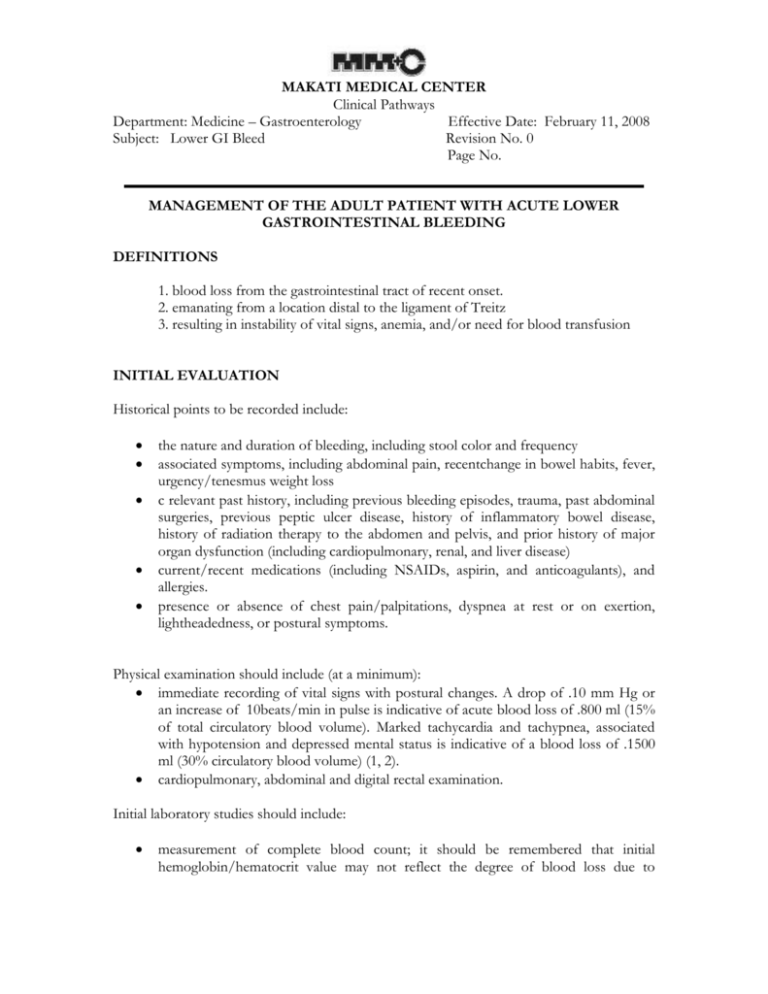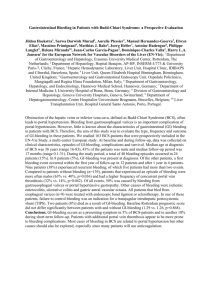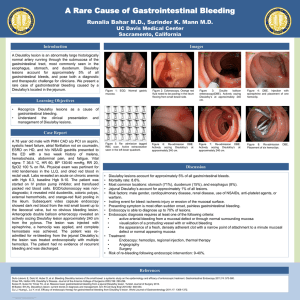LOWER GI BLEED - medicine department
advertisement

MAKATI MEDICAL CENTER Clinical Pathways Department: Medicine – Gastroenterology Effective Date: February 11, 2008 Subject: Lower GI Bleed Revision No. 0 Page No. MANAGEMENT OF THE ADULT PATIENT WITH ACUTE LOWER GASTROINTESTINAL BLEEDING DEFINITIONS 1. blood loss from the gastrointestinal tract of recent onset. 2. emanating from a location distal to the ligament of Treitz 3. resulting in instability of vital signs, anemia, and/or need for blood transfusion INITIAL EVALUATION Historical points to be recorded include: the nature and duration of bleeding, including stool color and frequency associated symptoms, including abdominal pain, recentchange in bowel habits, fever, urgency/tenesmus weight loss c relevant past history, including previous bleeding episodes, trauma, past abdominal surgeries, previous peptic ulcer disease, history of inflammatory bowel disease, history of radiation therapy to the abdomen and pelvis, and prior history of major organ dysfunction (including cardiopulmonary, renal, and liver disease) current/recent medications (including NSAIDs, aspirin, and anticoagulants), and allergies. presence or absence of chest pain/palpitations, dyspnea at rest or on exertion, lightheadedness, or postural symptoms. Physical examination should include (at a minimum): immediate recording of vital signs with postural changes. A drop of .10 mm Hg or an increase of 10beats/min in pulse is indicative of acute blood loss of .800 ml (15% of total circulatory blood volume). Marked tachycardia and tachypnea, associated with hypotension and depressed mental status is indicative of a blood loss of .1500 ml (30% circulatory blood volume) (1, 2). cardiopulmonary, abdominal and digital rectal examination. Initial laboratory studies should include: measurement of complete blood count; it should be remembered that initial hemoglobin/hematocrit value may not reflect the degree of blood loss due to MAKATI MEDICAL CENTER Clinical Pathways Department: Medicine – Gastroenterology Effective Date: February 11, 2008 Subject: Lower GI Bleed Revision No. 0 Page No. volume contraction, and may fall significantly after hydration. serum electrolytes, blood urea nitrogen, and creatinine. In upper gastrointestinal bleeding, the serum blood urea nitrogen may rise without a commensurate rise in serum creatinine. This appears to be due to absorption of proteins from blood in the gastrointestinal tract, and from dehydration (3–5). However, the absence of a rise in blood urea nitrogen does not rule out an upper gastrointestinal source. coagulation profile (PT/PTT), particularly if there is any history of liver disease or if the patient has been taking anticoagulant medication type and crossmatch electrocardiogram for patients .50 yr of age, younger patients with risk factors for coronary artery disease or history of dysrhythmia, or patients with chest pain/ palpitations associated with the bleeding episode Characteristics of the group at high risk for adverse outcomes were: a greater prevalence of comorbid illness (renal, hepatic, pulmonary, hematological, neurological, or cardiac), a lower serum albumin, a higher prothrombin time, and a higher serum bilirubin Admission to the intensive care unit or other monitored setting is appropriate for those individuals not responding to initial resuscitation measures (i.e., persistent hypotension/tachycardia and need for transfusion). DETERMINATION OF THE SOURCE OF BLEEDING MAKATI MEDICAL CENTER Clinical Pathways Department: Medicine – Gastroenterology Effective Date: February 11, 2008 Subject: Lower GI Bleed Revision No. 0 Page No. In the patient with hematochezia, an upper gastrointestinal bleeding source must be considered. A nasogastric aspirate showing copious amounts of bile and negative for blood makes an upper gastrointestinal source unlikely. Upper gastrointestinal endoscopy should be performed if the results of nasogastric aspiration shows evidence of upper gastrointestinal bleeding, or is negative for blood and bile. Endoscopy (colonoscopy or sigmoidoscopy) is the test of choice for the structural evaluation of lower gastrointestinal bleeding. Arteriography should be reserved for those patients with massive, ongoing bleeding when endoscopy is not feasible, or with persistent/recurrent hematochezia when colonoscopy has not revealed a source. There is no role for barium enema in the evaluation of acute, severe hematochezia. Patients with persistent or recurrent lower gastrointestinal bleeding may require surgery. Accurate presurgical localization of the bleeding site improves postoperative morbidity and mortality. In cases of lower gastrointestinal bleeding where no plausible colonic source is identified, evaluation of the small bowel may be necessary. Evaluation for a Meckel’s diverticulum should be performed in younger patients with acute lower gastrointestinal bleeding. Enteroscopy and small bowel radiography may also be performed in the patient in whom active bleeding has ceased. MAKATI MEDICAL CENTER Clinical Pathways Department: Medicine – Gastroenterology Effective Date: February 11, 2008 Subject: Lower GI Bleed Revision No. 0 Page No. Reference: Management of the Adult Patient with Acute Lower Gastrointestinal Bleeding Gregory Zuccaro, Jr., M.D., THE AMERICAN JOURNAL OF GASTROENTEROLOGY Vol. 93, No. 8, 1998 MAKATI MEDICAL CENTER Clinical Pathways Department: Medicine – Gastroenterology Effective Date: February 11, 2008 Subject: Lower GI Bleed Revision No. 0 Page No.










